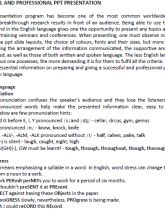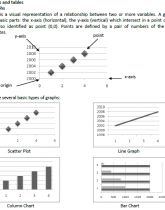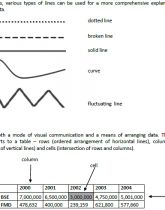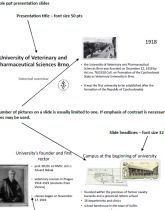Hledej
Zobraz:
Univerzity
Kategorie
Rozšířené vyhledávání
12 663
projektů
Succesfull and proffesional presentation
| Přípona |
Typ studijní materiál |
Stažené 0 x |
| Velikost 0,6 MB |
Jazyk anglický |
ID projektu 5009 |
| Poslední úprava 09.02.2015 |
Zobrazeno 1 433 x |
Autor: stefan.potocky |
 Sdílej na Facebooku
Sdílej na Facebooku |
||
| Detaily projektu | ||
- Cena:
2 Kreditů - kvalita:
86,2% -
Stáhni
- Přidej na srovnání
- Univerzita:Veterinární a farmaceutická univerzita Brno
- Fakulta:Farmaceutická fakulta
- Kategorie:Technika » Informatika
- Předmět:Informatika
- Studijní obor:-
- Ročník:3. ročník
- Formát:PDF dokument (.pdf)
- Rozsah A4:6 stran
1. Spoken language
1.1. Pronunciation
Improper pronunciation confuses the speaker’s audience and they lose the listeners’ attention. Correctly pronounced words help make the presented information clear, easy to follow and enjoyable. Below are few pronunciation hints:
C and G before E, I, Y pronounced /s/and /dʒ/ - cellar, circus, gym, genius
KN- pronounced /n/ - know, knock, knife
-ALF, -ALV-, -ALM, -ALK pronounced without /l/ - half, calves, palm, talk
-GH(-) is silent - laugh, caught, eight, high
(-)OU(GH)(-), OW must be learnt! - tough, through, throughout, though, thorough, thought
1.2. Word stress
Word stress means emphasizing a syllable in a word. In English, word stress can change the meaning of a word from a noun to a verb.
A work PERmit perMITs you to work for a period of six months.
We shouldn’t preSENT it at PREsent.
I obJECT against having these OBjects in the paper.
We proGRESS slowly, nevertheless, PROgress is being made.
I wish I could reCORD this REcord.
1.3. Sentence stress - the music of English
Sentence stress helps understand rapid spoken English. It gives English its rhythm. Content words, words carrying meaning, are stressed.
main verbs: tell, give, employ
nouns: germ, food, veterinarian
adjectives: red, round, interesting
adverbs: daily, promptly, never
negative auxiliaries: don’t, aren’t, can’t
numbers: one, hundred, three fourths
On the other hand, structure words, grammar words, remain unstressed.
pronouns: he, we, they
prepositions: on, at, into
articles: a, an, the
conjunctions: and, but, due to
auxiliary verbs: do, be, have, can, must
Contaminated food is one of the most common causes of illness in today’s world.
1.1. Pronunciation
Improper pronunciation confuses the speaker’s audience and they lose the listeners’ attention. Correctly pronounced words help make the presented information clear, easy to follow and enjoyable. Below are few pronunciation hints:
C and G before E, I, Y pronounced /s/and /dʒ/ - cellar, circus, gym, genius
KN- pronounced /n/ - know, knock, knife
-ALF, -ALV-, -ALM, -ALK pronounced without /l/ - half, calves, palm, talk
-GH(-) is silent - laugh, caught, eight, high
(-)OU(GH)(-), OW must be learnt! - tough, through, throughout, though, thorough, thought
1.2. Word stress
Word stress means emphasizing a syllable in a word. In English, word stress can change the meaning of a word from a noun to a verb.
A work PERmit perMITs you to work for a period of six months.
We shouldn’t preSENT it at PREsent.
I obJECT against having these OBjects in the paper.
We proGRESS slowly, nevertheless, PROgress is being made.
I wish I could reCORD this REcord.
1.3. Sentence stress - the music of English
Sentence stress helps understand rapid spoken English. It gives English its rhythm. Content words, words carrying meaning, are stressed.
main verbs: tell, give, employ
nouns: germ, food, veterinarian
adjectives: red, round, interesting
adverbs: daily, promptly, never
negative auxiliaries: don’t, aren’t, can’t
numbers: one, hundred, three fourths
On the other hand, structure words, grammar words, remain unstressed.
pronouns: he, we, they
prepositions: on, at, into
articles: a, an, the
conjunctions: and, but, due to
auxiliary verbs: do, be, have, can, must
Contaminated food is one of the most common causes of illness in today’s world.
Klíčová slova:
Presentation
Language
Pronunciation
Word
Stress
Sentence
English
Adverbs
Mouns
Verbs
Numbers
Conjunction
Lexis
Voice
Obsah:
- 1. Spoken language
1.1. Pronunciation
1.2. Word stress
1.3. Sentence stress-the music of English
1.4. Lexis
1.5. Active voice
2. Language on slides
2.1. Reduction
2.2. Word order
2.3. Unified spelling
2.4. Numbers and measurements
3. Graphs and tables
3.1. Graphs
3.2. Tables
4. Parts of presentation
4.1. Introduction
4.2. The body
4.3. Conclusion
4.4. Discussion and questions



